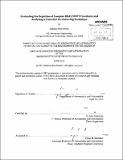| dc.contributor.advisor | R. John Hansman. | en_US |
| dc.contributor.author | Butchibabu, Abhizna | en_US |
| dc.contributor.other | Massachusetts Institute of Technology. Dept. of Aeronautics and Astronautics. | en_US |
| dc.date.accessioned | 2013-01-07T21:20:08Z | |
| dc.date.available | 2013-01-07T21:20:08Z | |
| dc.date.copyright | 2012 | en_US |
| dc.date.issued | 2012 | en_US |
| dc.identifier.uri | http://hdl.handle.net/1721.1/76094 | |
| dc.description | Thesis (S.M.)--Massachusetts Institute of Technology, Dept. of Aeronautics and Astronautics, 2012. | en_US |
| dc.description | Cataloged from PDF version of thesis. | en_US |
| dc.description | Includes bibliographical references (p. 110-112). | en_US |
| dc.description.abstract | Performance Based Navigation (PBN) is a key element of the Federal Aviation Administration's (FAA) NextGen Program. In order to increase National Airspace System (NAS) capacity and efficiency, PBN routes and procedures are being developed, including Area Navigation (RNAV) and Required Navigation Performance (RNP) procedures. RNAV enables aircraft to fly directly from point-to-point on any desired flight path using groundor spaced-based navigation aids. RNP is RNAV with the addition of onboard monitoring and alerting capability. Both RNAV and RNP procedures allow aircraft to fly accurate routes without relying on ground-based navigation aids. RNAV and RNP procedures facilitate more efficient design of airspace and procedures, offering significant safety improvements and flexibility to negotiate terrain, as well as improving airspace capacity and operational efficiency. The initial implementation of RNAV and RNAV (RNP) procedures has raised several human factors issues. RNAV (RNP) Instrument Approach Procedures (IAP) and RNAV Standard Instrument Departures (SID) and Standard Terminal Arrivals (STARs) often have more waypoints, altitude constraints and other elements than conventional procedures, resulting in charts being cartographically complex. Thus, a chart review was conducted to objectively understand the procedure elements that contributed to increased information density and high levels of visual clutter. A total of sixty-three approach, fifty-two departure, and fifty-four arrival procedures were analyzed. Primary findings were that the factors associated with high levels of visual clutter included having multiple flight paths per page for approach and departure procedures, and having complex altitude constraints for arrival procedures. Multiple waypoints per path was also a factor for both arrivals and approaches. In addition, having RF legs were additional factor contributing to visual clutter for approach procedures. One method to mitigate the increased information density and visual clutter on the RNAV and RNP procedure depiction is to reduce the number of flight paths shown on a single page by separating the depicted paths to multiple pages. However, there are a number of drawbacks to this clutter mitigation technique. Example drawbacks include having more paper to carry in the flight deck and more time spent searching for the correct page within a set of separated pages. An experiment was conducted to determine the effect of reducing the number of paths depicted on single-page "Modified" charts. FAA AeroNav Products and Jeppesen created versions of the Modified chart in their standard cartographical conventions. The experiment was conducted to evaluate whether these Modified charts would impact information retrieval time and accuracy compared with the "Current" charts being used now. Current FAA AeroNav Products and Jeppesen charts were used as the baseline condition. Six procedures were studied, including three RNAV departure procedures from Dallas/Fort Worth, Las Vegas, and Salt Lake City airports, and three RNAV (RNP) approach procedures from Boise, Bozeman, and Palm Springs airports. During the experiment, pilots were shown the same procedure in Current and Modified chart formats. All charts were displayed electronically on a high-resolution computer monitor. Pilots were asked information retrieval questions associated with each chart. Pilot response time and accuracy with which pilots answered the information retrieval questions were recorded. Pilots completed the task in two blocks, one for approaches and one for departures. The Current and Modified charts within each block were presented in random order, and the order of the two blocks was counterbalanced. Each block began with six practice questions. Each session took approximately one hour to complete. Data were collected from 28 commercial airline pilots and 19 corporate pilots with average flight experience of 11,484 hours. Fourteen pilots used FAA AeroNav charts, and 33 pilots used Jeppesen charts. Pilots were found to answer questions faster using Modified charts than Current charts. This effect was statistically significant with a p-value less than 0.01. For approach procedures, the mean response time for Current charts was 16.9 seconds, compared with 10.6 seconds for Modified charts. For departure procedures, the mean response time for Current charts was 16.2 seconds, compared with 13.2 seconds for Modified charts. Response times were also significantly faster for Modified charts than for Current charts when analyzed for each airport, chart manufacturer (Jeppesen and FAA AeroNav Products), and pilot type (Corporate and Airline). Overall question response accuracy for all 47 participants was 99.5%. There were no statistically significant differences found for the response accuracy between Modified and Current chart use. | en_US |
| dc.description.statementofresponsibility | by Abhizna Butchibabu. | en_US |
| dc.format.extent | 216 p. | en_US |
| dc.language.iso | eng | en_US |
| dc.publisher | Massachusetts Institute of Technology | en_US |
| dc.rights | M.I.T. theses are protected by
copyright. They may be viewed from this source for any purpose, but
reproduction or distribution in any format is prohibited without written
permission. See provided URL for inquiries about permission. | en_US |
| dc.rights.uri | http://dspace.mit.edu/handle/1721.1/7582 | en_US |
| dc.subject | Aeronautics and Astronautics. | en_US |
| dc.title | Evaluating the depiction of complex RNAV/RNP procedures and analyzing a potential de-cluttering technique | en_US |
| dc.title.alternative | Evaluating the depiction of complex Area Navigation/Required Navigation Performance procedures and analyzing a potential de-cluttering technique | en_US |
| dc.type | Thesis | en_US |
| dc.description.degree | S.M. | en_US |
| dc.contributor.department | Massachusetts Institute of Technology. Department of Aeronautics and Astronautics | |
| dc.identifier.oclc | 820453104 | en_US |
